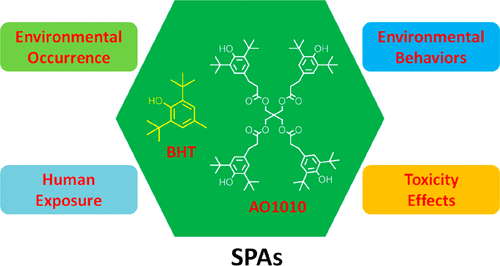当前位置:
X-MOL 学术
›
Environ. Sci. Technol.
›
论文详情
Our official English website, www.x-mol.net, welcomes your feedback! (Note: you will need to create a separate account there.)
Synthetic Phenolic Antioxidants: A Review of Environmental Occurrence, Fate, Human Exposure, and Toxicity.
Environmental Science & Technology ( IF 11.4 ) Pub Date : 2020-09-11 , DOI: 10.1021/acs.est.0c05077 Runzeng Liu 1 , Scott A Mabury 1
Environmental Science & Technology ( IF 11.4 ) Pub Date : 2020-09-11 , DOI: 10.1021/acs.est.0c05077 Runzeng Liu 1 , Scott A Mabury 1
Affiliation

|
Synthetic phenolic antioxidants (SPAs) are widely used in various industrial and commercial products to retard oxidative reactions and lengthen product shelf life. In recent years, numerous studies have been conducted on the environmental occurrence, human exposure, and toxicity of SPAs. Here, we summarize the current understanding of these issues and provide recommendations for future research directions. SPAs have been detected in various environmental matrices including indoor dust, outdoor air particulates, sea sediment, and river water. Recent studies have also observed the occurrence of SPAs, such as 2,6-di-tert-butyl-4-methylphenol (BHT) and 2,4-di-tert-butyl-phenol (DBP), in humans (fat tissues, serum, urine, breast milk, and fingernails). In addition to these parent compounds, some transformation products have also been detected both in the environment and in humans. Human exposure pathways include food intake, dust ingestion, and use of personal care products. For breastfeeding infants, breast milk may be an important exposure pathway. Toxicity studies suggest some SPAs may cause hepatic toxicity, have endocrine disrupting effects, or even be carcinogenic. The toxicity effects of some transformation products are likely worse than those of the parent compound. For example, 2,6-di-tert-butyl-p-benzoquinone (BHT-Q) can cause DNA damage at low concentrations. Future studies should investigate the contamination and environmental behaviors of novel high molecular weight SPAs, toxicity effects of coexposure to several SPAs, and toxicity effects on infants. Future studies should also develop novel SPAs with low toxicity and low migration ability, decreasing the potential for environmental pollution.
中文翻译:

合成酚类抗氧化剂:环境发生,命运,人体暴露和毒性的综述。
合成酚类抗氧化剂(SPA)被广泛用于各种工业和商业产品中,以延迟氧化反应并延长产品的保质期。近年来,对SPA的环境发生,人体暴露和毒性进行了大量研究。在这里,我们总结了对这些问题的当前理解,并为以后的研究方向提供了建议。在各种环境基质中都检测到了SPA,包括室内灰尘,室外空气颗粒,海洋沉积物和河水。最近的研究还观察到了SPA的发生,例如2,6-二叔丁基-4-甲基苯酚(BHT)和2,4-二叔丁基人(脂肪组织,血清,尿液,母乳和指甲)中的叔丁基苯酚(DBP)。除了这些母体化合物外,还已经在环境和人类中检测到一些转化产物。人体暴露途径包括食物摄入,灰尘摄入和个人护理产品的使用。对于母乳喂养的婴儿,母乳可能是重要的接触途径。毒性研究表明,某些SPA可能引起肝毒性,具有内分泌干扰作用,甚至具有致癌性。一些转化产物的毒性作用可能比母体化合物的毒性作用更差。例如,2,6-二-叔丁基- p-苯醌(BHT-Q)在低浓度下会引起DNA损伤。未来的研究应调查新型高分子量SPA的污染和环境行为,共同暴露于几种SPA的毒性作用以及对婴儿的毒性作用。未来的研究还应该开发具有低毒性和低迁移能力的新型SPA,以减少环境污染的可能性。
更新日期:2020-10-06
中文翻译:

合成酚类抗氧化剂:环境发生,命运,人体暴露和毒性的综述。
合成酚类抗氧化剂(SPA)被广泛用于各种工业和商业产品中,以延迟氧化反应并延长产品的保质期。近年来,对SPA的环境发生,人体暴露和毒性进行了大量研究。在这里,我们总结了对这些问题的当前理解,并为以后的研究方向提供了建议。在各种环境基质中都检测到了SPA,包括室内灰尘,室外空气颗粒,海洋沉积物和河水。最近的研究还观察到了SPA的发生,例如2,6-二叔丁基-4-甲基苯酚(BHT)和2,4-二叔丁基人(脂肪组织,血清,尿液,母乳和指甲)中的叔丁基苯酚(DBP)。除了这些母体化合物外,还已经在环境和人类中检测到一些转化产物。人体暴露途径包括食物摄入,灰尘摄入和个人护理产品的使用。对于母乳喂养的婴儿,母乳可能是重要的接触途径。毒性研究表明,某些SPA可能引起肝毒性,具有内分泌干扰作用,甚至具有致癌性。一些转化产物的毒性作用可能比母体化合物的毒性作用更差。例如,2,6-二-叔丁基- p-苯醌(BHT-Q)在低浓度下会引起DNA损伤。未来的研究应调查新型高分子量SPA的污染和环境行为,共同暴露于几种SPA的毒性作用以及对婴儿的毒性作用。未来的研究还应该开发具有低毒性和低迁移能力的新型SPA,以减少环境污染的可能性。



























 京公网安备 11010802027423号
京公网安备 11010802027423号